Adding Arduino Boards to Your Integrated Components Libraries

An Arduino board is a great way to include standard functionality in your next PCB. If you want to use an Arduino board in your PCB design software, you’ll need to include Arduino boards as part of your component libraries. This allows you to incorporate Arduino boards into your electronics schematics, layouts, and bills of materials. You can use Arduino boards as the backbone for your next product, or as part of a larger multi-board system. Altium Designer contains the design and component tools you need to add Arduino boards to your next project.
ALTIUM DESIGNER
A heavily rules-driven PCB design platform for designing the best PCBs.
Whether you’re a hobbyist, student, or serious designer, using an Arduino board as the backbone for your next PCB is a great way to break into new areas of electronics design. If you’re a student or hobbyist that doesn’t have time to learn all the finer points of PCB design, you can still build your new idea on the back of a versatile platform that has a small form factor, plenty of analog and digital I/O connections, built-in memory, USB communication, and MHz clock speeds.
If you’re a serious designer or you want to build a proof-of-concept for your new startup, these boards are a great option for building a functional prototype of your new board. You can even incorporate Arduino boards into a product with definite packaging and other components as part of a multi-board system. You can easily program them using many languages. Is it any wonder that Arduino boards have become a mainstay in embedded computing?
If you want to use an Arduino board in your next device, you need PCB design software that includes all the information and specifications on Arduino boards as part of your component libraries. Your PCB design software should allow you to incorporate an Arduino board as a mechanically attached component on a board, or as its own board within a multi-board system.
Arduino IDE, Arduino Sketch, and the Arduino custom library tool require coding knowledge for best functionality. Whether you are versed in this skill set or not, high functioning PCB design software will greatly expedite the design process, from the Arduino Leonardo (aka Arduino nano) to a full-sized board. Equally important, powerful software will prevent errors and inefficiencies making it to the manufacturing phase, wasting time and money. In the end, more advanced software can save money, time, frustration, and projects.
Diving into PCB Design with Arduino
If you want to start working with Arduino boards as the backbone of your next PCB, you’ll need some amount of electronics knowledge beyond PCB design. Arduino boards come with a built-in microcontroller, plenty of analog and digital I/O connections, and a sizeable amount of onboard memory. You’ll need to know how to use all of these components when you build your next device using an Arduino board.
The great thing about using an Arduino nano or full-sized board is that you don’t need to have a massive level of PCB design knowledge. Instead, these boards allow you to connect the components you need, as well as connect to other boards you have designed as part of your project. Arduino boards ensure signal integrity and durability compared to a breadboard. These components can be managed with streamlined library manager software like Altium, or the Arduino custom library if you have an understanding of open source software and coding.
If you want to design around an Arduino board using your PCB design software, your software needs to include Arduino boards as part of your component libraries. If you plan to work with a multi-board system, or even mount an Arduino board as part of a larger PCB, you’ll need design tools that make it easy to integrate multiple boards into a single system. Your PCB design software should include the most comprehensive component information that integrates directly with your design tools.
Including Arduino Boards in Your Next PCB
Incorporating an Arduino board takes PCB design software with thorough component libraries that include a variety of Arduino models that you use as the backbone of your next device. It all starts with adding an Arduino board into your electronics schematic. You can easily add capabilities to these boards with external devices directly from your schematic editor. You can then capture your schematic and as an initial layout and watch your new idea come to life.
If you ever plan to produce a real device built on an Arduino board, your design software needs to generate deliverables for your manufacturer that includes your Arduino board in your bill of materials. Rather than adding this information by hand, a great PCB design software package should add this information for your manufacturer/assembler automatically by grabbing data directly from the Arduino library folder or a component library manager.
- If you want to integrate multiple boards into a single system, an Arduino board helps you to take a modular approach to PCB design once you decide to integrate multiple boards.
- Do you need an 8-bit or 32-bit MCU for your next PCB? Choosing an Arduino board with the right MCU is critical for data processing. Learn more about choosing the right MCU for your PCB.
- Your PCB design software should make it easy to source components like an Arduino board in your PCB. Learn more about sourcing components with integrated component libraries.

3D multi-board PCB design in Altium Designer
Adding Arduino to Your Schematics and Layouts
Designing your next PCB begins with building a great electronics schematic that shows how your components are linked together into a complete device. This document is more than just a simple functional draft. Your PCB design software must access information on your components from your component libraries when you build your schematic. This information is used for rules checking, simulations, and building your initial layout.
Once you’ve put your components together in a schematic, your software, whether Arduino Ide or the advanced Altium Designer, needs to capture your schematic as an initial layout so that you can start arranging your components on your board. Your component library also needs to include 2D and 3D models for your components that show how connections are arranged on your board. After capturing your schematic as a layout, you can start arranging components and building connections between your components.
Moving Beyond Arduino
Top-notch PCB design software with extensive component libraries will allow you to add Arduino controllers to your schematics and your board layout, either as a standalone board or as a multi-board system. You’ll finally move from a schematic showing simple connections between components to an actual board that resembles a real product. Only the best PCB design software gives you access to all of these features in a unified environment.
Adding functionality to your product that goes beyond the capabilities built into an Arduino controller will require linking multiple schematics into a multi-board system. PCB design software that uses hierarchical schematic design makes it easy to link together multiple schematics into a complete system. This makes it easy to segregate features into functional blocks and helps you organize your design before you build your board layout.
- One easy way to work with an Arduino controller is to use it in hierarchical schematics. Learn how to use hierarchical schematics in your PCB design software.
- When working with any controller board, you’ll need to use rule checking features to verify your electronics schematic.
- If you are collaborating with a team of designers or engineers, the best PCB design software makes data sharing and version control easy. See how your PCB design software can make collaboration easy.

The unified design interface in Altium Designer
The Unified Environment in Altium Designer
Arduino boards combine memory, a microcontroller, multiple inputs and outputs, and external connectivity in a single device. Designing around an Arduino board takes design software with the best CAD, schematic, component management, and simulation tools you can get. These tools help you take advantage of all the capabilities Arduino boards offer, allowing you to integrate these functions into your own designs.
Only Altium Designer packages all of these PCB design tools and more into a single interface. While Arduino Ide offers a basic software platform, Altium also gives you access to a massive component library, making it easy to include an Arduino controller in your next device or design a custom controller from scratch. If you value your time, your design software should be powerful enough to replace Arduino Ide and the Arduino library manager, giving you full control over your new device and imbuing it with greater capabilities.
Controller Design in a Unified Environment
If you’re ready to move past an Arduino board and build your own controller, your design software should be fully adaptable for any application. The rules-driven design engine in Altium Designer ensures that all aspects of your design software and your components communicate in the same language. Unifying your design tools into a single workflow with a consistent data structure keeps your productivity high and helps you design the latest and greatest PCBs.
Other design software packages might claim to operate in a unified environment, but none of these other software programs truly integrate your design, component management, and analysis tools in a single design module. Instead of switching between multiple programs with inconsistent workflows, using Altium Designer gives you access to all these tools and more in a single program.
- The rules-driven design engine unifies your PCB workflow and helps you build PCBs that include Arduino boards. Learn more about rules-driven design in Altium Designer.
- Locating and researching components for your PCB doesn’t need to be a chore when your design software includes component search features. Learn more about searching components in Altium Designer.
- Devices with Arduino boards will likely be multi-board systems. Altium Designer makes it easy to link your boards together with connectors are flex ribbons. Learn more about multi-board design in Altium Designer.
If your next product will be built on top of an Arduino board, Altium Designer includes the design features and component library tools you need to work with these useful systems. You can use an Arduino board as a standalone controller or as part of a larger multi-board system. These boards are very adaptable and are a great way to quickly add powerful functionality to your next project.
Coming up to speed with new design software can be difficult, especially if you’re left to learn the product on your own. Altium wants you to succeed as you fall down the rabbit hole of PCB design. You’ll also have access to useful design examples, a thorough knowledge base, the AltiumLive forum, podcasts, and webinars provided by industry experts. Altium gives you have all the support you need to design successfully.
When you want to build your next device around an Arduino board, you need PCB design software with thorough component libraries, multi-board management tools, and manufacturing deliverable tools. Altium Designer is the only PCB design software platform that unifies all these features and mission-critical design tools in a single rules-driven environment. If you’re ready for a new type of PCB design platform that allows you to incorporate any component you can imagine, then you need to try Altium Designer.
